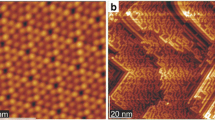Abstract.
The growth of CaF2 on vicinal Si (111) surfaces was studied by scanning tunneling microscopy (STM) and atomic force microscopy (AFM) for the temperature range from 300 to 750 °C. In the submonolayer range a transition from terrace to step nucleation is observed for increasing temperature. The first monolayer grows in the step-flow growth mode since second layer islands are not nucleated before completion of the wetting layer. For the subsequent growth of CaF2 on the CaF interface layer, substrate-induced steps do not act as preferential nucleation sites, but rather as growth barriers. Thus CaF2 films grow very inhomogeneously at high temperatures. At lower deposition temperatures, the film homogeneity increases due to the increased (homogeneous) nucleation rate on terraces. The lattice mismatch leads to (lateral) relaxation of thicker CaF2 film close to substrate steps. In addition, CaF2 self-decoration effects are caused by the relaxed regions close to the film steps at temperatures above 500 °C.
Similar content being viewed by others
Author information
Authors and Affiliations
Additional information
Received: 7 August 2001 / Accepted: 23 October 2001 / Published online: 3 April 2002
Rights and permissions
About this article
Cite this article
Wollschläger, J. Substrate-step-induced effects on the growth of CaF2 on Si (111) . Appl Phys A 75, 155–166 (2002). https://doi.org/10.1007/s003390101064
Issue Date:
DOI: https://doi.org/10.1007/s003390101064




